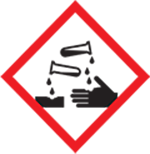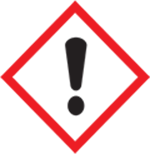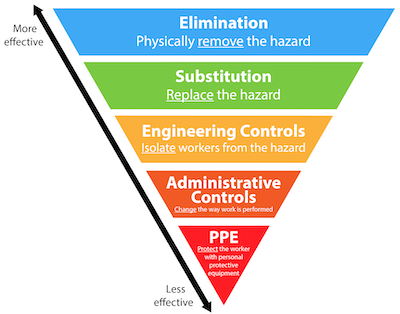Phosphoric Acid
This chemical standard operating procedure (SOP) and the associated Safety Data Sheet (SDS) are for our safety. Read and understand both documents. If this is a paper copy, check for updated versions on the IsoLab website.
Process
We use phosphoric acid to digest carbonate in our carbonate clumped isotope sample preparation as well as in our carbonate bulk isotope analysis.
Hazards - SDS


May be corrosive to metals. Harmful if swallowed. Causes severe skin burns and eye damage.
Protection - SDS

Engineering Controls
Concentrated phosphoric acid should only be used in a fume hood, not for fumes but for containment.
Administrative Controls
If you are sharing a fume hood with someone and you will be working with phosphoric acid, make certain they are aware.
Personal Protective Equipment (PPE)
When working with phosphoric acid, eye protection, nitrile gloves, and a laboratory coat.
Handling - SDS
Keep container tightly closed when not in use. Make sure you have your laboratory coat, eye protection, and gloves on before handling the bottle.
Storage - SDS
Phosphoric acid is stored in two locations. 100% phosphoric acid is stored in the 60 °C oven in 303B near the East Fume Hood or in the Corrosives Cabinet under the fume hood in 302A. Use MyChem, the UW EH&S chemical inventory database, to find exactly where in the lab suite this chemical is stored.
Spills - SDS
Exposure:
- Inhalation - Remove person to fresh air and keep comfortable for breathing. Immediately call the Washington Poinson Center (800.222.1222) or a physician or 911.
- Skin contact - In case of skin contact, remove all contaminated clothing. Rinse skin with water / shower.
- Eye contact - Rinse cautiously with water for several minutes. Remove contact lenses, if present and easy to do. Continue rinsing. Immediately call the Washington Poison Center (800.222.1222) or a physician or 911.
If the spill is fully contained inside the fume hood, close the sash and prepare yourself to clean it up. Grab the closest spill kit. Make sure you have the appropriate PPE on (lab coat, nitrile gloves, eye protection). Do not allow the substance to enter the drain. Use liquid-absorbent material to soak up the chemical. Put all generated waste into a bag. See Waste section below.
If the spill is outside of the hood, don appropriate PPE and grab a spill kit.
If you need assistance or advice, use the IsoLab Emergency Contacts sheet.
Consult the EH&S Spill Poster and Exposure Poster
Waste - SDS
If you are cleaning up after a spill and have a bag of debris, ensure the bag is sealed and use multiple bags as needed. Complete an EH&S Hazardous Waste Label and adhere it to the bag. Here are instructions for how to label chemical waste containers. Labels are located in a drawer on the west wall of 303B near the door to the hallway.
Phosphoric acid waste should go into a waste container. Options for waste containers can be found under the west sink in 303B. Complete an EH&S Hazardous Waste Label and adhere it to the bottle. Here are instructions for how to label chemical waste containers. Labels are located in a drawer on the west wall of 303B near the door to the hallway.
Place the properly labeled container in one of the gray tubs near the hallway door of 303B. Segregate from other waste containers as appropriate.
Consult our generalized Chemical Waste Disposal SOP.
Training
Phosphoric acid is not deemed a particularly hazardous substance by EH&S and you do not need approval before using it. You do need to complete the list of requirements below before using this chemical.
Prerequisites
- You must have completed Managing Laboratory Chemicals in the last three years. Login to check.
- Read and understand the SDS for phosphoric acid.
- Read, understand, and digitally sign this SOP.
